Last updated: December 17, 2024
Article
Explore Careers: Yellowstone National Park 2021 #WhatWeDoWednesdays
Are you curious about the people who work in Yellowstone National Park?
We began highlighting the diversity of work done by Yellowstone employees in our #WhatWeDoWednesdays social media campaign. From investigating wolf kill sites, to grooming park roads in winter, to monitoring climate sites, there are many types of positions that help preserve the park's natural and cultural resources for the enjoyment, education, and inspiration of this and future generations.
Learn more about the variety of work park employees accomplish below and view current open positions in Yellowstone.

Creating 3D Models Using Photogrammetry
Did you know Yellowstone creates 3D models of hydrothermal features using a technique called photogrammetry?
Employees like Maaz and Morgan photograph the features from multiple angles and then process the images to create workable models. These “snapshots” will allow us to study how features change over time and also help researchers model eruption styles.
“I’m excited that our work is laying the foundation for future geomorphological research. It will be interesting to watch how Yellowstone's hydrothermal features will physically change in the years ahead.” –Maaz Fareedi, Physical Science Technician
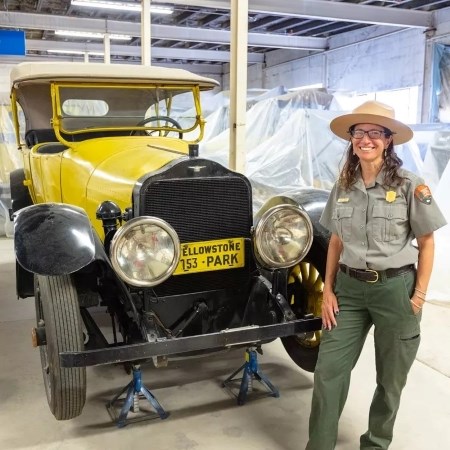
Curating the Historic Vehicle Collection
Did you know Yellowstone preserves more than 40 vehicles dating from the 1880s to near present day?
Employees like Miriam research and share stories of the Historic Vehicle Collection, which includes a surrey used by the U.S. Army (circa 1905), Tally-Ho stagecoaches (circa 1890s-1910s), soft-top touring buses operated by concessionaires (circa 1930s), a fire truck that can pump water from natural sources (circa 1960s), two scooters used by park rangers in the campgrounds (circa 1970s), and even a snowmobile (2001)!
“I never thought that I’d drain the oil from a 1916 truck or vacuum a stagecoach. I love the thought that I'm helping preserve the many stories of Yellowstone for future generations to learn from and enjoy!” –Miriam Watson, Museum Curator

Delivering Mail During Winter
Did you know Yellowstone has four seasonal post offices?
When they close for the winter, employees like Rachel are responsible for making the 150-mile trip two times per week to deliver mail, supplies, and equipment to 120 people living in areas of the park accessible only by snowmobile or snowcoach.
"In 12 winters, I've had to travel through blizzards and whiteout conditions, but it’s all worth the effort when you see how excited people are to get their mail! I love that my job brings people joy, especially during a time of year when living in isolated locations can be challenging.” –Rachel Cudmore, Winter Courier
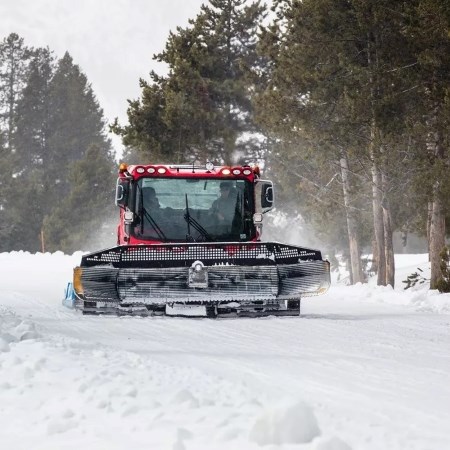
Grooming Roads in Winter
Did you know Yellowstone maintains 180+ miles of roads for oversnow vehicles?
From mid-December to mid-March, many of the park entrances and attractions are only accessible by snowmobile or snowcoach. Each night, employees like William groom the roads to ensure safe travel for visitors the following day.
“Grooming during a storm really makes you appreciate snow poles, reflector tape, and my coworkers who put them there. In complete darkness and with only 5 feet of visibility, the blowing snow makes my 9 m.p.h. feel like warp speed!” –William Wright, Equipment Operator

Hosting Naturalization Ceremonies
Did you know Yellowstone partners with the U.S. Citizenship and Immigration Services to host naturalization ceremonies?
Since 2014, the partners and Judge Carman have welcomed 248 new U.S. citizens from 59 countries around the world after taking their Oath of Allegiance in the park.
“Performing the naturalization ceremony has been the highlight of my Judicial career. Hearing the stories of these world citizens who have sacrificed and worked for years to join us as citizens of our United States should remind all of us, that despite our tribulations, we remain a beacon of hope to much of the world.” –The Honorable Mark L. Carman, U.S. Magistrate Judge
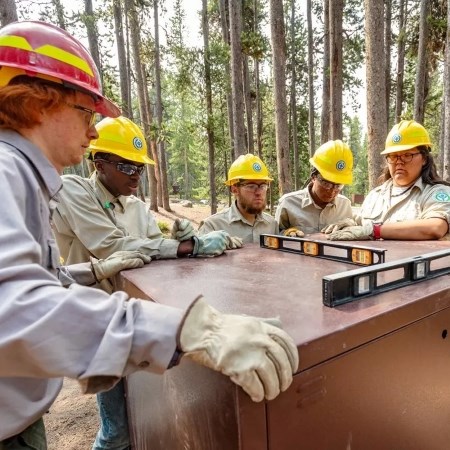
Installing Bear Boxes
Did you know Yellowstone is working to install bear-proof food storage boxes in all 2,000 frontcountry campsites?
Bear boxes improve visitor safety and reduce the chances a bear or other animal gets human food, which often leads to their removal in management actions. Over the last 10 years, Youth Conservation Corps (YCC) crews and employees like Sam have installed over 1,000 bear boxes. With financial support from Yellowstone Forever, the expected completion date is 2026.
“It's rewarding to help YCC teenagers master new skills like using hand tools, mixing concrete, and team problem solving to place these 400-pound bear boxes. It’s easy to see the tangible results of the crew's hard work and the intangible growth in confidence that comes from knowing they've done something that will help protect visitors and Yellowstone's wildlife for years to come.” –Sam Archibald, Crew Leader
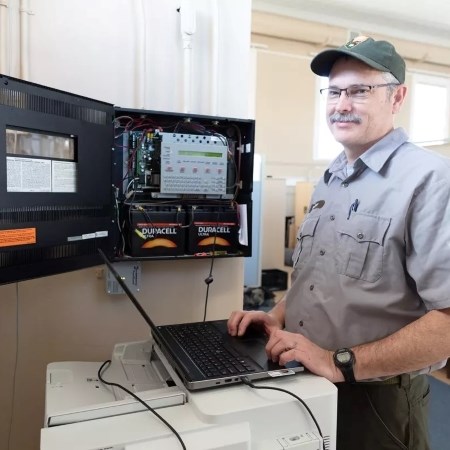
Installing Intelligent Alarms Systems
Did you know Yellowstone maintains 300 intelligent alarms systems?
In accordance with the National Fire Alarm Code, employees like Dan are certified to design, install, inspect, and repair park alarm systems upon completion of a rigorous accreditation program.
“There’s no room for error when dealing with fire safety. When smoke or fire is detected, alarms must activate immediately and notify the people inside the building and first responders 100% of the time.” –Dan Brown, Electronics Technician

Investigating Wolf Kill Sites
Did you know Yellowstone collects data on what wolves eat?
Once a site has been identified, employees like Doug will ski or hike to the location to collect bone and teeth samples from the prey. The data is then added to the 26 years of research since wolves were reintroduced in 1995.
“Yellowstone continues to be one of the best places to observe predator-prey relationships, and the data we collect helps guide wolf research and conservation all over the world.” –Doug Smith, Senior Wildlife Biologist
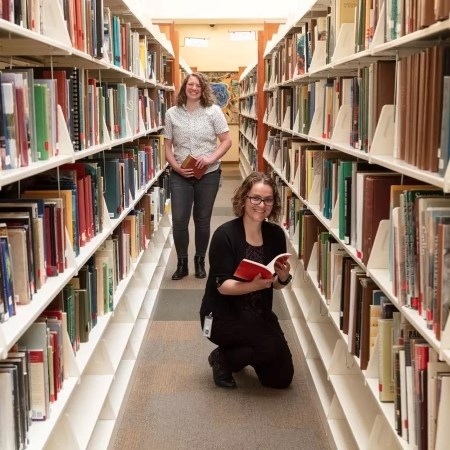
Maintaining Library Collections
Did you know Yellowstone has a growing research library with over 20,000 books, movies, music, and articles?
Employees like Sarah dig into our collections to help people learn about the area’s history, wildlife, geography, and unique stories. Call, email, or stop by the Heritage and Research Center next time you’re in the area!
“You never know what people are going to ask--it could be about the remains of a structure they saw along a trail or what elk eat in the winter. It's rewarding to help people find new connections with Yellowstone through the topics that interest them the most." –Sarah Marino, Research Librarian

Maintaining a Micro Hydroelectric Generator
Did you know Yellowstone maintains a micro hydroelectric generator?
Installed as a part of the park’s water treatment facility system in 2012, the generator offsets about $75K in electricity costs and 1,500 tons of CO2 emissions each year. Employees like Peter perform routine checks on the system, which should run for at least 30 years before a major overhaul is required.
“Before I joined the National Park Service 22 years ago, I worked in hydro generation for the City of Los Angeles. My former coworkers thought it was pretty cool I got to build a hydro plant in Yellowstone.” –Peter Galindo, Mechanical Engineer
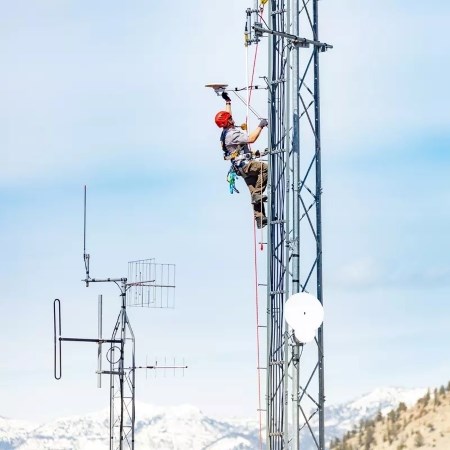
Maintaining Radio Communications Equipment
Did you know Yellowstone maintains a radio communications network covering over 2 million acres?
Each year, employees like Dave visit hundreds of pieces of equipment throughout the park on foot, skis, and sometimes helicopter to inspect, upgrade, or repair the network. Their work ensures that Yellowstone employees in the field can communicate with each other and emergency services, via the communications center.
“Managing a communications network in a wild place like Yellowstone is challenging, but when you’re working on top of a peak like Top Notch with views all around you, the job is a dream come true.” –Dave Kelser, Electronics Technician

Managing Fleet Operations
Did you know Yellowstone manages the largest fleet in the National Park Service, totaling a combined 1,000 vehicles, snowmobiles, and trailers?
When the average vehicle reaches its end of life, employees like April purchase new vehicles to support operations throughout the park. Their work to improve vehicle emissions also earned the team the Green Fleet Award in 2020!
“Managing a fleet this big comes with many challenges but overcoming them is my favorite part of the job. I look for a way, not a way out!” –April Browning, Fleet Operations
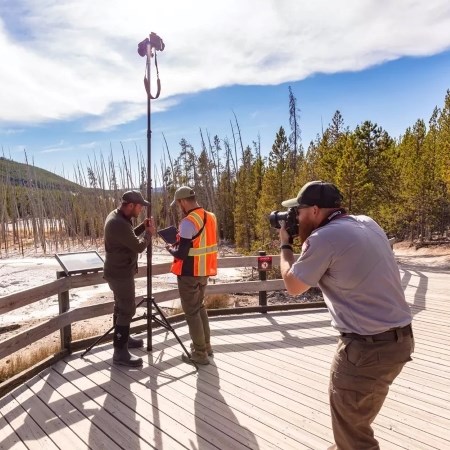
Managing our Public Domain Multimedia Collection
Did you know Yellowstone manages a multimedia collection?
When employees like Jake shoot photos and video or record audio for media projects, the public domain content is available for anyone to download and use. So, if you need a video clip for that class project or a photo for your living room, we’ve got you covered.
“I’m fully aware how lucky I am to share Yellowstone with people through photos and video. My favorite project I’ve worked on has been #WhatWeDoWednesdays. Highlighting my coworkers and the work that goes into keeping this park running has been a great learning experience for me. Hopefully everyone enjoys it as much as I have!” –Jake Frank, Audiovisual Production Specialist

Monitoring Climate Sites
Did you know Yellowstone maintains the oldest, continuously operated weather station in Wyoming, which dates to 1894?
Today, employees like Ben maintain a network of climate stations to study the variability of meteorological data across different elevations of the park. With hotter temperatures and 30 fewer days per year with snow on the ground than in the 1960s, park planners are looking for proactive ways to protect its people and resources.
“A warming, drying climate not only impacts park resources, but how you enjoy the park too. This summer we’ve had smoky skies for months and even had to close some places to fishing because the water was too hot.” – Ben Banet, GIS Technician
Learn more about climate change in Yellowstone.

Partnering with Salish Kootenai College
Did you know Yellowstone partners with Salish Kootenai College to conduct research on archeological resources?
In addition to increasing the park's database of specific sites, students like Toddie gain field experience to complement their classroom studies.
"It’s nice to bridge indigenous archeology perspectives with conventional archaeology. This partnership's purpose will help us strive towards a more inclusive future." –Toddie Buffalo, SKC Tribal Historic Preservation student

Partnering with Yellowstone Volcano Observatory
Did you know Yellowstone partners with nine state and federal agencies to monitor volcanic, hydrothermal, and earthquake activity in the Yellowstone region?
Known as the Yellowstone Volcano Observatory (YVO), employees and partners like Jeff work to better understand what’s happening beneath the ground to forecast imminent hazardous activity. P.S. There are no signs of the volcano erupting anytime soon!
“One example of innovative YVO research is by University of Utah using nodal seismometers. They allow us to 'see' how the ground moves in three dimensions over time and in relation to other events, like geyser eruptions. Maybe one day we’ll be able to predict geysers like Steamboat.” –Jeff Hungerford, Park Geologist

Performing Energy Audits
Did you know Yellowstone performs energy audits on park housing?
In addition to updating lighting and appliances, employees like Rachel look to improve efficiency by locating air leakage points using a blower door and thermal imaging. By addressing these hidden air leaks and weakened insulation, the park estimates a savings of 15% in energy consumption for housing. With nearly 450 housing units within the park, this will compound to big savings!
“Living in Yellowstone is living in extremes – severe cold, heavy snow, and strong winds. Energy audits give us an opportunity to reduce energy consumption, improve sustainability, and take care of our employees." –Rachel Dodgen, Asset Manager

Plowing Park Roads
Did you know it takes nearly three months to plow 250 miles of road and parking lots in Yellowstone each spring?
Employees like Brian begin plowing near Mammoth Hot Springs in early March and complete operations along the Beartooth Highway in late May, weather depending. It’s also common for roads to temporarily close and need plowing again after spring snowstorms.
“When we plow the Beartooth Highway in May, we’re in full winter gear. When we get back to Mammoth at the end of the day, people are walking around in flip flops and shorts. It’s like transporting to another world in a 50-mile drive.” –Brian Batzloff, Equipment Operator

Preparing Park Roads for Winter Travel
Did you know most of the roads in Yellowstone close to regular vehicles during the winter?
Every fall, employees like Eric install nearly 20,000 snow stakes throughout the park. The stakes mark the edge of the road for two main purposes—to guide snowplows on roads we want to keep snow free, and to guide groomers on roads we maintain for snowmobiles and snowcoaches.
“Snow stakes aren’t a scenic addition, but they’re essential for winter operations. Whether you’re visiting or an employee living in the park, snow stakes are there to help you travel through Yellowstone during this spectacular time of year.” –Eric Holdren, Equipment Operator
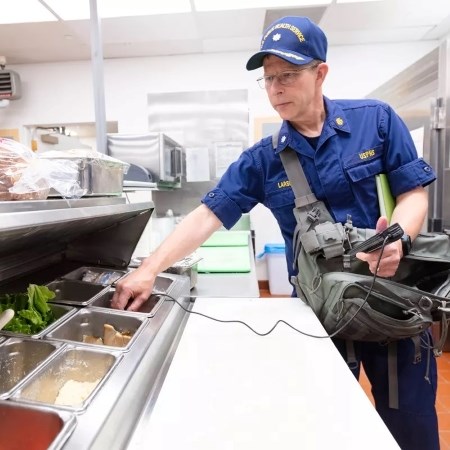
Protecting Public Health
Did you know the National Park Service is the only U.S. land management agency with an Office of Public Health?
This year, Yellowstone commemorates the 100-year anniversary of the partnership with the U.S. Public Health Service and NPS. Commissioned officers like George provide services that include surveying drinking water and wastewater systems, inspecting food vendors, and responding to and preventing illness outbreaks.
“In addition to being an incredible natural and cultural resource, parks are also a powerful resource to promote human health. Our partnership mitigates the risk of people getting sick while they visit, so they can focus on getting out and exploring the wonders of Yellowstone." –Commander George Larsen, Public Health Consultant
Did you know Yellowstone removes hazard trees from campgrounds and picnic areas? “During a wind storm a few years ago, we had a live tree fall on a campground host’s RV. Thankfully, everyone was OK, but the RV was totaled. It was a great reminder of the importance of this work to keep people safe.” –Brian Teets, Resource Management Coordinator

Replacing Trailhead Signs
Did you know Yellowstone has 1,100 miles of trails?
To improve visitor experience and safety, Youth Conservation Corps (YCC) crews and employees like Allison are replacing outdated trailhead exhibits with new, matching ones. Designed in-house and fabricated with funding from Yellowstone Forever, all 96 trailheads should have new signs by the end of 2022.
“The best part of the project is seeing the pride YCC crews have in their work–it’s contagious! While the signs will stay in park, crew members take home the confidence they get from building something that hikers visiting from around the world will enjoy.” –Allison Newberg, YCC Director

Restoring Bison Across the U.S.
Did you know Yellowstone coordinates with Tribal, federal, state, and nonprofit partners to transfer bison to American Indian Tribes?
The Bison Conservation Transfer Program and employees like Chris and Doug have transferred 154 brucellosis-free bison to the Fort Peck Tribes since 2019. Of those, 82 were sent to 17 other Tribes across the country. In partnership with Yellowstone Forever and Greater Yellowstone Coalition, the park plans to more than double the capacity of the program as an alternative to slaughter.
“Not only is the program making history, it’s the right thing to do. Moving bison in coordination with surrounding states gives bison more room to roam and allows people who value bison an opportunity to start new herds across the country.” –Chris Geremia, Senior Bison Biologist
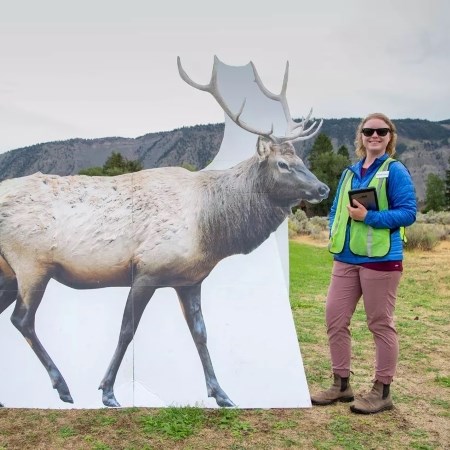
Studying Human Behavior Around Elk
Did you know Yellowstone has partnered with researchers at Penn State University to study people’s behavior around elk?
In collaboration with the park’s social science program and the Leave No Trace Center for Outdoor Ethics, doctoral student Stephanie Freeman is studying how different messages influence how close people approach elk in Mammoth Hot Springs. The findings of this study will ultimately inform the park on better ways to communicate with people about wildlife safety, especially during times of the year when elk are more aggressive, like during the rut in autumn.
“After visiting Yellowstone National Park and seeing how close some people would approach wild animals, I became fascinated with studying the 'why.' Understanding the relationship between people and parks helps protect these special places for years to come!” – Stephanie Freeman, PSU Department of Recreation, Park and Tourism Management, PhD candidate

Testing Automated Vehicle Technology
Did you know Yellowstone’s annual visits have increased by 1 million in the last decade?
Using visitor use studies, transportation studies, and pilot projects, employees like Christina work to understand the impacts of increasing visitation in four key areas: park resources; staffing, operations, and infrastructure; visitor experience; and gateway communities and partners.
“We’re excited to be testing automated vehicle technology. The data we collect during this pilot has the possibility of shaping transportation for the entire National Park Service!” –Christina White, Coordinator for External Affairs & Visitor Use
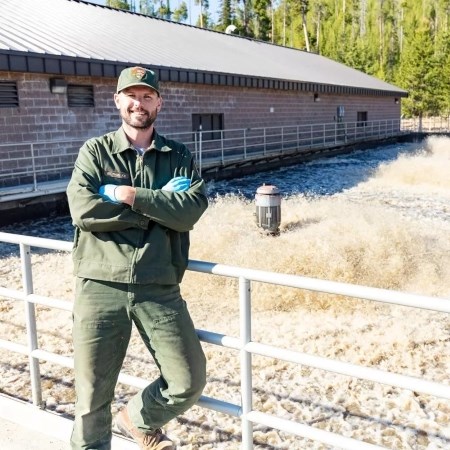
Treating Wastewater
Did you know Yellowstone maintains seven wastewater treatment facilities?
Utilizing a variety of processes, like Old Faithful’s activated sludge system, employees like Brett treated a combined 124 million gallons of wastewater in 2020. That’s enough wastewater to fill nearly 190 Olympic-sized pools!
“If you’d like to say hi to the team, just flush us a note!” –Brett Thielke, Utility System Operator
